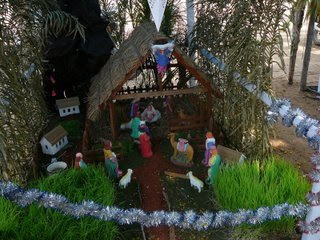Sapota @ our parambu (backyard)
Sapodilla can grow to more than 30 m (98 ft) tall with an average
trunk diameter of 1.5 m (4.9 ft). The average height of cultivated
specimens, however, is usually between 9 and 15 m (30 and 49 ft) with a
trunk diameter not exceeding 50 cm (20 in) It is wind-resistant and the bark is rich in a white, gummy latex called chicle. The ornamental leaves are medium green and glossy. They are alternate, elliptic to ovate, 7–15 cm long, with an entire margin. The white flowers are inconspicuous and bell-like, with a six-lobed corolla.
The fruit is a large ellipsoid berry, 4–8 cm in diameter, very much resembling a smooth-skinned potato and containing two to five seeds. Inside, its flesh ranges from a pale yellow to an earthy brown color with a grainy texture akin to that of a well-ripened pear. The seeds are black and resemble beans, with a hook at one end that can catch in the throat if swallowed. The fruit has a high latex content and does not ripen until picked, whereupon the fruit softens to a firmness and appearance very similar to that of a fuzzy, brown-skinned kiwifruit.
The fruit has an exceptionally sweet, malty flavor. Many believe the flavor bears a striking resemblance to caramel or a pear candied with brown sugar. The unripe fruit is hard to the touch and contains high amounts of saponin, which has astringent properties similar to tannin, drying out the mouth.
The trees can only survive in warm, typically tropical environments, dying easily if the temperature drops below freezing. From germination, the sapodilla tree will usually take anywhere from five to eight years to bear fruit. The sapodilla trees yield fruit twice a year, though flowering may continue year
The fruit is a large ellipsoid berry, 4–8 cm in diameter, very much resembling a smooth-skinned potato and containing two to five seeds. Inside, its flesh ranges from a pale yellow to an earthy brown color with a grainy texture akin to that of a well-ripened pear. The seeds are black and resemble beans, with a hook at one end that can catch in the throat if swallowed. The fruit has a high latex content and does not ripen until picked, whereupon the fruit softens to a firmness and appearance very similar to that of a fuzzy, brown-skinned kiwifruit.
The fruit has an exceptionally sweet, malty flavor. Many believe the flavor bears a striking resemblance to caramel or a pear candied with brown sugar. The unripe fruit is hard to the touch and contains high amounts of saponin, which has astringent properties similar to tannin, drying out the mouth.
The trees can only survive in warm, typically tropical environments, dying easily if the temperature drops below freezing. From germination, the sapodilla tree will usually take anywhere from five to eight years to bear fruit. The sapodilla trees yield fruit twice a year, though flowering may continue year






Comments